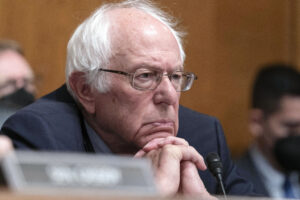An Open Letter to the Green Party for 2020
Because real solutions require removing Donald Trump from office, the party must reconsider its contested-states strategy this November. Green Party leader Howie Hawkins. (YouTube screenshot)
Green Party leader Howie Hawkins. (YouTube screenshot)
As the 2020 presidential election approaches the Green Party faces the challenge of settling on a platform, choosing a candidate for president, and deciding its campaign strategy. In that context, Howie Hawkins, a contender for Green Party presidential candidate, recently published a clear and cogent essay titled “The Green Party Is Not the Democrats’ Problem.” It represents a precedent Green Party stance which may guide Green campaign policy. We agree with much, but find some ideas very troubling.
The stance offered in Hawkins’ article says “the assertion that the Green Party spoiled the 2000 and 2016 elections is a shallow explanation for the Democrats’ losses;” that in 2000, “the Supreme Court…stopped the Florida recount;” that many factors “elected Trump in 2016…including black voter suppression, Comey publicly reopening the Clinton email case a week before the election, $6 billion of free publicity for Trump from the commercial media, and a Clinton campaign that failed to get enough of its Democratic base out;” that the Electoral College “gave the presidency to the loser of the popular vote;” that most Greens are “furious” at a Democratic party “that joins with Republicans to support domestic austerity and a bloated military budget and endless wars;” “that the Green Party’s Green New Deal science-based timeline, would put the country on a World War II scale emergency footing to transform the economy to zero greenhouse gas emissions and 100% clean energy by 2030;” and that “the Green Party want(s) to eliminate poverty and radically reduce inequality“ including a job guarantee, a guaranteed income above poverty, affordable housing, improved Medicare for all, lifelong public education from pre-K through college, and a secure retirement;” and finally that the Green Party strategy “is to build the party from the bottom up by electing thousands to municipal and county offices, state legislatures, and soon the House as we go into the 2020s.”
We agree that many factors led to Democratic Party losses and that the Supreme Court was a big one as was the Electoral College, and we too are furious at Democrats joining Republicans in so many violations of justice and peace. Likewise, we admire the Greens’ Green New Deal and economic justice commitments, and also support a grassroots, local office approach to winning electoral gains.
So with all that agreement, why are we sending a critical open letter?
The stance the article presents, which may guide the Green campaign for president, says, “To hold all other factors (contributing to recent Presidential victories) constant and focus on the Green Party as the deciding factor is a hypothetical that is a logical fallacy because it assumes away a factual reality: the Green Party is here to stay.” However, our finding Green policy a factor in Republican victories in no way suggests that the Green Party should disappear. And our focus on factors within our reach to easily correct (for example, the Green Party role in contested states) is in fact sensible.
The stance also says “the Green Party is not why the Democrats lost to Bush and Trump,” but even if true, that wouldn’t demonstrate it won’t be why this time. In any case, let’s take Trump and Clinton, and see how Green Party policy mattered.
If Clinton got Jill Stein’s Green votes in Pennsylvania, Wisconsin, and Michigan, Clinton would have won the election. Thus, the Green Party’s decision to run in those states, saying even that there was little or no difference between Trump and Clinton, seems to us to be a factor worthy of being removed from contested state dynamics, just like the Electoral College is a factor worthy of being removed across all states.
We realize many and perhaps most Greens will respond that if those who voted for Stein in contested states in 2016 hadn’t done so, they would have abstained. We don’t know how anyone could know that, but for the sake of argument we will suppose it is correct.
Still, if these voters who preferred Stein did indeed erroneously believe that there was no difference between Trump and Clinton, surely to some degree that was a result of Stein refusing to acknowledge the special danger of Trump, and insisting that while it would be bad if Trump won it would also be bad if Clinton won, and refusing to state any preference.
Similarly, if these Stein voters did indeed erroneously believe that no harm could come from casting a vote for Stein in a close state in a close election, that also to some degree was surely a result of Green campaigning insisting that Green voters bore no responsibility for the 2000 election result.
And finally, if these voters did indeed erroneously believe that it was immoral to contaminate themselves by voting for Clinton or for a Democrat, surely in part that too was encouraged by Green campaigning that treated voting as a feel-good activity (“vote your hopes, not your fears”) as if fear of climate disaster, for example, shouldn’t be a motivator for political action.
The stance says, “The Green Party is not going back to the ‘safe states strategy’ that a faction of it attempted in 2004.” This means they will not forgo running in contested states where Green votes could swing the outcome as happened in Pennsylvania, Wisconsin, and Michigan in 2016, and they will not run in only 40 safe states where the outcome will be a foregone conclusion.
But why reject a safe states strategy?
Like Stein in 2016, some might claim doing so can’t help Trump win again or, in any case, that Trump’s re-election would not matter all that much. “He isn’t that much worse.”
We write in hopes that no one in 2020 will rationalize campaign actions by making such irresponsible and patently false claims.
And, indeed, in his recent essay, Hawkins instead claimed a safe states strategy “couldn’t even be carried out. It alienated Greens in swing states who were working so hard to overcome onerous petitioning requirements to get the party on the ballot. Keeping the party on the ballot for the next election cycle for their local candidates depended on the Green presidential vote in many states. It became clear that safe states was dispiriting and demoralizing because the party didn’t take itself seriously enough to justify its existence independent of the Democrats. Few people, even in the safe states, wanted to waste their vote for a Green ticket that was more concerned with electing the Democratic ticket than advancing its own demands.”
This claims there is a price the Green Party has to pay for a safe states strategy. Okay, let’s take that as gospel. Where is an argument that this price is so great that avoiding it outweighs the price everyone, including Greens, will pay for re-electing Trump?
We have no way to assess the claim that Greens would find it dispiriting to remove themselves as a factor that might abet global catastrophe via a Trump re-election. But wouldn’t Trump out of office much less Sanders or Warren in office not only benefit all humanity and a good part of the biosphere to boot, but also the Green Party? For that matter, weren’t more potential Green Party members and voters driven off by the party’s dismissal of the dangers of Trump than were inspired by it? Which grew more in the last four years, DSA or the Greens?
And weren’t the Greens in the late ’80s and early ’90s winning elections to city councils and other local offices across the country, consistent with a grass roots strategy, though for much of the past 20 years, they’ve largely abandoned local and state contests, devoting nearly all their attention to increasingly harmful races for president? Hawkins’ own exemplary races for Senate and Governor in New York state, and especially the Greens’ successful mayoral races in politically important places like Richmond, CA, as well as less visible ones like New Paltz, NY, were exceptions, but how many Greens have used their hard-won ballot access to run for Congress or state legislature? Might the massive focus on presidential elections mark a decline in prospects for the localist strategy, not an advance for it?
We are told, “Greens want to get Trump out as much as anybody” but how can that be if Greens would vote for a Green candidate, and not for Sanders, Warren, or any Democrat in a contested state knowing that doing so could mean Trump’s victory?
If during the 2020 election campaign, the Green candidate campaigns in contested states knowing that he or she might be winning votes that would otherwise have gone to Sanders or to Warren or whoever, causing Trump to win the state and win the electoral college, how could that possibly evidence wanting Trump to lose as much as anyone?
Indeed, if a Green candidate weren’t telling everyone who was a potential Green voter to vote for Trump’s opponent in contested states, how could that evidence that Greens want Trump to lose as much as anyone?
Let us put our question another way. It is election night 2020. The vote tallies are in. Which way would the 2020 Green candidate feel better? Trump wins and the Green candidate gets 250,000 votes across the contested states, more than enough for Sanders, Warren, or whoever to have won? Or, Trump loses and the Green candidate gets no votes in the contested states, but a bunch extra in other states as a result of having more time for campaigning there?
Greens tell Democrats “to stop worrying about the Green Party and focus on getting your own base out.” We agree on the importance of Democrats getting their base out, starting with nominating Sanders, or, at worst, Warren. But how does that warrant the Green Party risking contributing to Trump winning?
The stance asks, “So why are we running a presidential ticket in 2020 if our strategy is to build the party from the bottom up?” The stance answers, “Because Greens need ballot lines to run local candidates. Securing ballot lines for the next election cycle is affected by the petition signatures and/or votes for our presidential ticket in 40 of the states.”
Greens will pay a price for not running in contested states. Our advice to Greens would be to notice the infinitely bigger price that millions and even billions of people will pay for Trump winning.
The stance says “Greens don’t spoil elections. We improve them. We advance solutions that otherwise won’t get raised. We are running out of time on the climate crisis, inequality, and nuclear weapons. Greens will be damned if we wait for the Democrats. Real solutions can’t wait.”
But real solutions require Trump out of office. Real solutions will become far more probable with Sanders or Warren in office. Real solutions will become somewhat more probable even with the likes of Biden in office.
To conclude, is a Green candidate running for President after the summer really going to argue we shouldn’t vote for Sanders in contested states not just to end Trumpism but also to enact all kinds of important changes including urging and facilitating grass roots activism and thereby advancing Green program?
We offer this open letter in hopes of prodding discussion of the issues raised.
Your support is crucial…With an uncertain future and a new administration casting doubt on press freedoms, the danger is clear: The truth is at risk.
Now is the time to give. Your tax-deductible support allows us to dig deeper, delivering fearless investigative reporting and analysis that exposes what’s really happening — without compromise.
Stand with our courageous journalists. Donate today to protect a free press, uphold democracy and unearth untold stories.









You need to be a supporter to comment.
There are currently no responses to this article.
Be the first to respond.